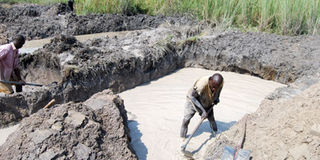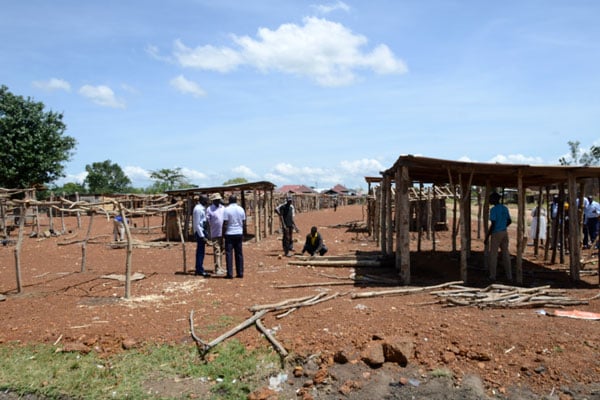Poverty, the driving force behind wetland degradation

Workers of Ssalongo Sekyembe dig up fish ponds in Nganjo on the periphery of Lutembe Bay wetland in Wakiso District. PHOTO BY GILLIAN NANTUME
What you need to know:
- In February 2017, the UPDF Fisheries Protection Unit began ‘Operation Pakalast’ to crack down on illegal fishing. In the course of confiscating illegal fishing gear in Kasenyi, a number of people have been assaulted by overzealous soldiers.
- By 2015, only 62.4 per cent of Lubigi was still intact, down from 94.7 per cent in 2003 due to the increased human settlements (with land titles) and farming activity inside the swamp.
- According to the Uganda Wetlands Atlas, wetland destruction costs Uganda nearly Shs2 billion annually, and contamination of water resources, which is partly caused by reduced buffering capacity of wetlands near open water bodies, costs the country nearly Shs38 billion annually.
Lubigi swamp is part of the vast 54.1 square kilometre Mayanja-Kato wetland and what remains of it is still rich in wildlife, such as sitatunga, bushbuck, and red-tailed monkeys. The main vegetation is papyrus. For a long time, Lubigi swamp has been considered a free stretch of land which anyone can lay claim to and as such it has undergone overharvesting of papyrus, cultivation of eucalyptus trees, deforestation, and hunting. The periphery of the swamp on the Kampala Northern Bypass Highway, is dotted with rubbish heaps strewn with kaveeras (polythene bags).
Bashir Sserwada is making a rich living selling reeds (ebisaalu) and horse purslane (kalandalugo) to feed cattle.
Every morning, Sserwada and the 30 youth he employees, go deep into Lubigi to cut reeds from his plot. They lay the reeds in batches on the Northern Bypass, near Kyengera. By midmorning, the reeds have been bought and the youths return to the swamp for more.
“I sell each batch at Shs40,000,” Sserwada says, adding, “Most of my customers are people in government, big soldiers [high ranking army officers] because they are the ones who have cows. Most of them take seven to 10 batches in one trip. I pay my workers Shs10,000 a day, and on a good day, I make a profit of Shs500,000 after paying them. On a bad day, I make about Shs200,000.”
It is 3pm and we are seated in the swamp, next to the stream that flows from Busega. All around us are gardens of maize and yams. In a distance is a cluster of eucalyptus trees belonging to one of the 200 people who earn a living from the 300-acre Lubigi.
“No one buys land here. People just come and take what they want. You can also come tomorrow and we give you a piece of land so that you can start making money. NEMA knows we are here. They only have a problem with us if we plant permanent gardens.”
Alex Were, 19, one of Sserwada’s workers, is also a hunter. Lubigi is teeming with bushbuck (ngabi), oribi antelope (mpeewo), and sitatunga (njobe).
“I sell every kilo of bush meat at Shs15,000,” Were says, adding, “Those animals can never get finished [extinct].”
When I ask about NEMA evicting encroachers they laugh scornfully. “NEMA officials cannot explore Lubigi,” Sserwada say, adding, “They stand on the road in their smart clothes and look at the swamp. Only a real man can enter Lubigi because the water is deep and there are wild animals. There is even a python inside there.”
Lubigi is also a breeding ground for clarias (emale) and lungfish (emamba). Fish traders from Busega market enter the swamp every morning and emerge with sacks of fish. “Government cannot chase us out the swamp,” Sserwada boasts, adding that the encroachers’ presence keeps the Northern Bypass safe.
Years of farming and unregulated human activities are destroying the capacity of Lubigi as a major filter of waste water and flood control for northern Kampala. For instance, during the rainy season, Lubigi takes excess water from River Nsooba, whose flood plain at Bwaise has been destroyed by human settlements.
Degrading wetlands with impunity
Lutembe Bay wetland is a Ramsar Site, making it the most important area for the conservation of water birds in Uganda, something Ssalongo Steven Ssekatawa laughs at. “I thought nature conservation was all about not cutting trees,” he says, adding, “How am I degrading the wetland by building fish ponds?”
Fifty years ago, Ssekatawa bought a kibanja next to a swamp in Ddewe from Prince Badru Kakungulu. The swamp forms part of Lutembe Bay wetland. First, he planted eucalyptus trees but now, his workers carrying out sand mining, selling two tonnes of sand at Shs70,000 and four tonnes at Shs110,000. Part of the swamp was depleted of sand and then, murram poured into it. A building is being built a few metres from fish ponds. Beyond the fishponds is a large maize garden.
“I am helping government to respond to the high demand for fish,” Ssekatawa reasons, continuing, “Soldiers are beating up fishermen at Kasenyi landing site; no one is allowed on the lake so the price of fish is quite high. Soon, I will start bringing dollars and pounds into this country, in form of taxes, when I begin exporting fish. People should stop being so conscious of the environment.”
In February 2017, the UPDF Fisheries Protection Unit began ‘Operation Pakalast’ to crack down on illegal fishing. In the course of confiscating illegal fishing gear in Kasenyi, a number of people have been assaulted by overzealous soldiers.
Although he does not have a wetland user permit, Ssekatawa says NEMA officials visit his four 32x26 fish ponds often. He claims to have certified permission from the Aquaculture Research and Development Centre in Kajjansi but he misplaced the certificate. Each pond has 10,000 fish, however, his challenge is keeping monitor lizards and ospreys (fish-eating birds) at bay. While ospreys are seasonal, monitor lizards are inhabitants of wetlands.
“I get rid of them,” Ssekatawa says, adding, “I kill them. If the law says it is wrong, then, the [law is] for bayaye (lumpens). I am helping my business grow by killing them.”
Ssekatawa plans to construct two more fish ponds. “I intend to put up a building there [where murram has been poured into the swamp]. Let NEMA stop those who are acquiring land in wetlands now, not us, who got it a long time ago.”
In Nganjo, a mile away from Ssekatawa’s fish ponds, residential houses have been built about 100 metres from the periphery of the wetland.
The smoothness of the ground betrays the fact that a grader has gone over those 100 metres to pave way for more construction.
Almost all the land in Nganjo, right up to the wetland, belongs to Ssalongo Sekyembe, a resident of Nansana Town. He declined to speak to this newspaper. His workers, though, are constructing fish ponds in Lutembe Bay at a supersonic speed.
In one week, they have dug 10 ponds. “We also mine sand for sale,” the foreman says, adding, “I know the swamp is a breeding ground for fish but we will fish from the outside to fill up our ponds.”
Ssekyembe’s niece, Nansubuga, who is in charge of the construction, is not sure if her uncle has a wetland user permit, but even after scrutinising my identity card, she believes I am a NEMA official and warns me not to return to the fish ponds.
Semi-large scale developments
On the other side of Lutembe Bay, near Entebbe Road, is Rosebud Limited owned by tycoon, Sudhir Ruperalia.
In 2013,Wakiso District halted the expansion of the flower farm , accusing it of degrading the wetland.
District officials accused NEMA of offering Rosebud a permit without consulting them.
Residents who have built houses next to the wetland accuse Rosebud of reclaiming more sections of the wetland in the last two years.
“They bring soil and heap it in a huge mound so that no one can see what is happening inside the farm,” one woman says, adding that two years ago, one such mound was pushed into the swamp, flattened and reinforced with murram and then, two greenhouse were built.
Another mound stands between the last greenhouse and the wetland. A satellite image in the Uganda Wetlands Atlas shows that infilling with murram to create dry ground for flower farm construction has been ongoing since 2013. There are other flower farms in the area that have been steadily expanding.
Behind Kajjansi Trading Centre, in Lumpewo wetland, Umoja Fish Farm is thriving illegally. The land initially belonged to Uganda Peoples Defense Air Force (UPDAF) but somehow, it changed hands and now belongs to Maj Laston Mugisha.
The farm has 11 ponds, each with 15,000 catfish. “I know this is a wetland,” Maj Mugisha says, continuing, “But, if NEMA can not disturb those putting up permanent structures in wetlands, why would they disturb me? Anyway, we have started the process of acquiring a permit.”
Maj Mugisha’s workers are digging up a large pond which he says will have 30,000 catfish.
His major challenge is floods. A stream that flows between the ponds bursts its banks during the rainy season.
Gen Mugisha has had to put measures in place to stop the stream from washing away his fish. “This area was not meant for fish ponds,” he concedes, adding, “In the last rainy season, I lost about Shs60 million. The other problem I have are the birds and monitor lizards that feed on the fish. We kill the monitor lizards.”
Activities that can only be done in wetlands
Qawwali swamp, behind Kajjansi Trading Centre, on Entebbe Road, is part of Lumpewo wetland system.
A large part of the swamp lies between two villages – Birongo and Lweza Zone B, before it narrows down to Lake Victoria.
In 1993, Siraje Tenywa bought a kibanja adjacent to Qawwali (Kawaali) swamp in Lweza Zone B, because he believed mining clay would make his rich.
Today, he employees more than 30 people in bricklaying, clay mining and manufacturing household items from the clay, and cultivation. He has never held a wetland user permit, although he claims to own half of the swamp, which is teeming with activity.
Cost of wetland degradation
According to the Uganda Wetlands Atlas, wetland destruction costs Uganda nearly Shs2 billion annually, and contamination of water resources, which is partly caused by reduced buffering capacity of wetlands near open water bodies, costs the country nearly Shs38 billion annually.
Collins Oloya, the commissioner, Wetlands Management Department, says, “Wetlands moderate local climate by virtue of the evapotranspiration from the leaves of the plants in the wetlands.” He adds that evapotranspiration forms water droplets (hanging vapour) which attract moisture laden winds to form rain. If the wetlands are destroyed this entire process will not happen, hence the drought that has plagued most parts of the country in the last few months.
“Wetlands accumulate and store semi decomposed (bit) soil which is composed of carbons. When wetlands are drained, the bit soil is exposed to oxidation and forms carbon dioxides. Carbon dioxide is a greenhouse gas which causes global warming.”
By 2015, only 62.4 per cent of Lubigi was still intact, down from 94.7 per cent in 2003 due to the increased human settlements (with land titles) and farming activity inside the swamp. The NWSC sewage treatment plant also contaminates the swamp and poses a health risk to the people living around the Mayanja-Kato wetland system since most of the papyrus which helps in filtration is being cut down.
Because of the destruction of Wakiso’s wetlands, Wakiso experiences intense heat waves. For instance, between December 2015 and January 2016, Uganda National Metrological Authority indicated that Kampala and Wakiso experienced a heat wave that drove daytime temperatures to 31.1˚C
Wetlands also sock up excess water during heavy rains but their degradation has led to increased flooding in and around Wakiso because water catchment areas for Wakiso’s many small rivers have been converted into slums.
However, due to urban migrations, the population explosion in Wakiso means the wetlands are under threat. According to Uganda Bureau of Statistics (UBOS), in 2002, Kampala was the most populous district with 1.2 million persons, while Wakiso had 907,988.
Today, Wakiso is the most populous district in Uganda more than two million people, most of whom are economic migrants.
In the third part tomorrow, we look at the challenges of enforcing conservation.




